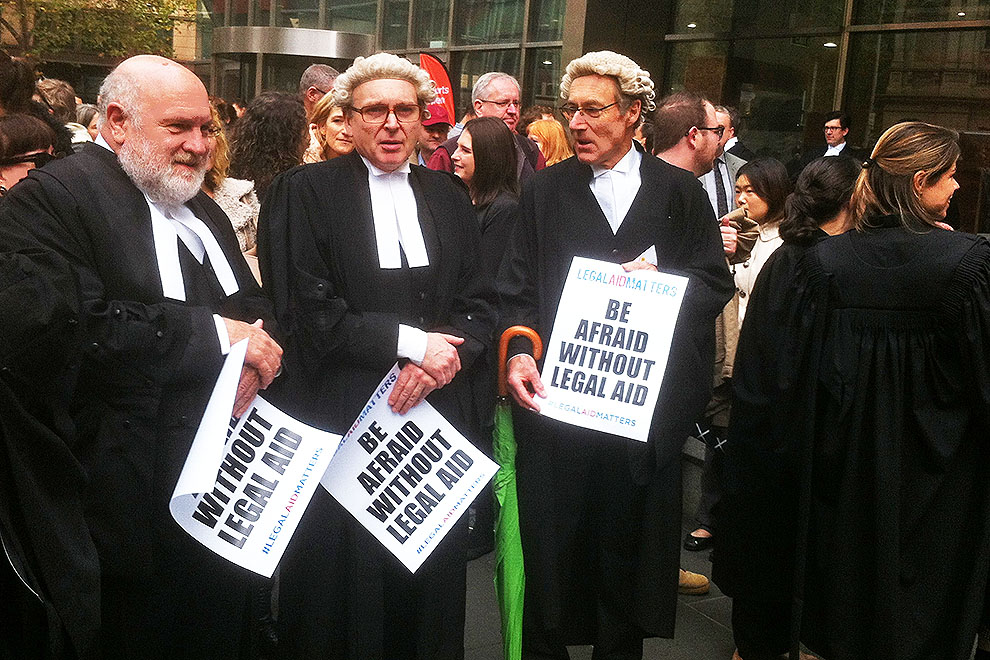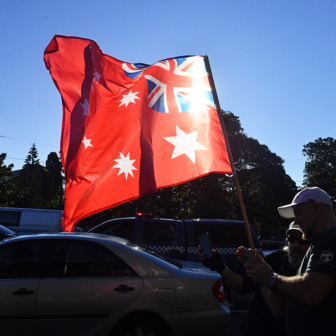It was at the polite end of the protest spectrum. As the hundreds of people rallying outside Melbourne’s County Court threatened to block pedestrian access along Lonsdale Street, solicitor Mark Woods reminded them that the Queen’s footpath must remain free to passing traffic.
But in the legal world, politeness often combines with passion, and this demonstration was no exception. Having called on us all to respect the right of way, Woods went on to describe what was happening inside the court complex that was our backdrop. More than 80 per cent of those appearing in court today, he said, would suffer from a mental illness, be a victim of domestic violence, have a problem with substance abuse, or be homeless or be unemployed. “More than 60 per cent of them will have been to court before,” said Woods, who chairs the Law Council of Australia’s Access to Justice committee. “Yet only a quarter would qualify for legal aid.”
Funding for legal aid has been declining in real terms for almost twenty years now, ever since the first cuts made by the Howard government in 1997. In per capita terms, according to retired judge Betty King QC, legal aid funding has almost halved.
“We are an adversarial system of justice,” King told the crowd. “It cannot be a fair system of justice when only one side gets the money to be represented in court.” King spent forty years working in the criminal justice system, the last ten on the bench of Victoria’s Supreme Court. “As a Supreme Court judge, I had the power to direct legal aid to represent an accused person if it was in the interests of justice,” she told the rally. “But that doesn’t happen in the magistrate’s court.”
The result, says King, is that a magistrate is forced into the position of becoming a de facto advocate, obliged to protect the person facing charges from unfair questions, explain all the court processes to them and ensure those explanations are fully understood. This is a formidable challenge when the accused may be poorly educated, intellectually challenged or mentally unwell. “Trials take up to twice as long,” said King. “That is a big cost to the community, when you consider the expense of running a court for just an hour.”
It is a cost not just to budgets but also to fairness. A person on a low income is only likely to qualify for legal aid if he or she faces a significant risk of going to prison, but even a non-custodial sentence can have a huge impact on a person’s life. “People who may not actually be guilty of the offence or some of the offences they are charged with, may face terrible consequences from a conviction, like losing custody of their child or losing their government subsidised house,” said King. “These are the ripples in the pond.”
Barrister David Neal, who also spoke at the rally, said legal aid is now so restricted that a pensioner would be unlikely to qualify for assistance. Neal said that 14 per cent of the Australian population live below the poverty line, yet only 8 per cent of the population have incomes under the threshold that renders them eligible for legal aid. “Can we say to them that the Australian system delivers equality before the law?” Neal asked the crowd.
Legal aid is generally only available in criminal, not civil, matters, which can leave a victim of domestic violence without representation in disputes with a violent partner over property or the custody of children. The defunding of legal aid has been compounded by cuts to community, Aboriginal and family violence prevention legal services, which are also forced to turn away tens of thousands of people seeking help.
Tuesday’s protest was timed to coincide with the County Court’s open day of tours and mock hearings for Law Week. Teachers bringing school groups along to see the wheels of justice turning got more than they bargained for as they negotiated their way through a crowd liberally sprinkled with barristers resplendent in wigs, gowns and immaculately laundered jabots.
What the organisers hadn’t anticipated was that the protest would also fall in the second week of a federal election campaign. But speakers took full advantage of that coincidence. While noting that some election promises had been made in relation to funding community legal centres and family violence prevention services, Law Council of Australia president Stuart Clark declared that the sums on offer so far were far from adequate. “Lives are being destroyed because people are left to fend for themselves in front of the courts,” he said.
Clark called on both sides of politics to commit to an immediate injection of $200 million into legal aid, as recommended by the Productivity Commission’s inquiry into access to justice arrangements. He noted that the inquiry began under a Labor federal government in 2013 and reported to a Coalition government at the end of 2014, yet neither side of politics has responded to its funding recommendation. The economically dry Productivity Commission, which is not usually known for encouraging greater government spending, said the increase was needed to better align the means tests used by legal aid commissions with other measures of disadvantage, and to maintain existing frontline services that have a demonstrated benefit to the community.
A $120 million increase in federal money would be enough to return the Commonwealth to funding a half share of legal aid with the states and territories, rather than the one-third share it has fallen to. The Law Council would like to see a similar level of funding committed to providing assistance in civil matters.
An increase in funding may not seem to align well with promises of “budget repair,” but Clark says the fiscal benefits are potentially huge. Adequate legal aid brings long-term savings, not just in court costs but also in areas like health and corrections. “Every dollar spent on legal aid has an economic return,” he said.
Steve Hynes, who runs Britain’s Legal Action Group, agrees. He told the crowd that evidence around the world shows that a dollar spent on legal assistance generates at least seven dollars in savings on other services. In some studies, he says, the return is found to be as high as $27. “You know if you lose your house, your children can end up in care,” said Hynes. “Parents can end up on government benefits. There are knock-on effects to the state. It makes sense to invest in legal aid.”
Hynes led a campaign against the Cameron government’s cuts to legal aid. There, barristers and solicitors didn’t stop at protests outside courthouses, but went as far as withdrawing their labour, refusing to appear in cases. “It was the poshest strike I’ve ever seen,” says Hynes. “There were wigs on the picket lines.” Hynes notes that it was described as a boycott, rather than a strike, since lawyers are essentially self-employed, but he says it got serious attention from the government, and the worst of the government’s funding cuts were reversed. Per capita, legal aid funding in Britain today is roughly double the allocation in Australia.
Whether Australia’s legal fraternity will go so far as boycotts or strikes remains to be seen, but it will certainly take determined action to achieve the vision outlined by the Whitlam government’s attorney-general, Lionel Murphy, in late 1973.
In a comprehensive statement on legal aid tabled in federal parliament, Murphy said that the government had decided to fund legal aid because “one of the basic causes of the inequality of citizens before the law is the absence of adequate and comprehensive legal aid arrangements throughout Australia.” An ordinary man or woman facing a legal problem should be able to get assistance “as readily as he or she would go to the garage with an ailing motor car,” said Murphy, noting that it is “usually the socially disadvantaged person who is unrepresented in magistrates’ courts and persons who are unrepresented are prejudiced.”
Today, legal aid funding has fallen so low that the situation appears little better than it was when Murphy tabled his statement almost forty-three years ago. Today, people who appear unrepresented before magistrates are “often downtrodden, life-weary, sad people, who don’t have a person to speak to about this crisis in their life,” said Betty King. “The removal of funding of this proportion is an erosion of people’s rights to be heard, to be listened to. It’s like saying their lives don’t matter.” •




